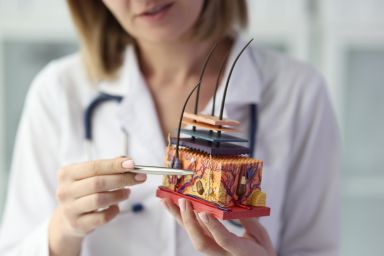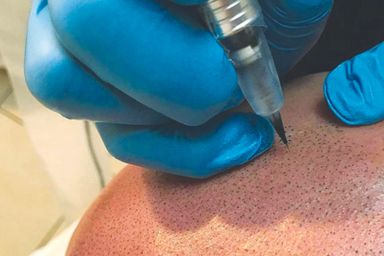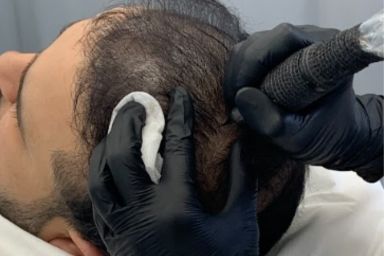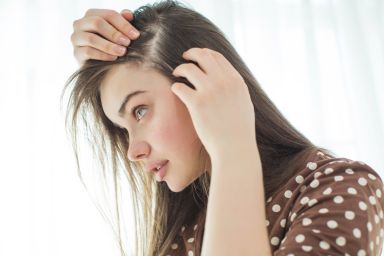Established for over 25 years
Clinics Nationwide
5 Star Google & Trustpilot Reviews
Scalp Micropigmentation Aftercare: A Comprehensive Guide

Achieving and maintaining the best results from SMP requires diligent aftercare. This comprehensive scalp micropigmentation aftercare guide will take you through what to expect after your SMP procedure, and the crucial steps to follow at each stage of the healing process. From the immediate post-treatment period to long-term maintenance, adhering to the recommended aftercare practices will ensure the longevity and vibrancy of your SMP.
Additionally, we'll cover how to recognise and respond to symptoms of infection, and the importance of regular touch-ups to keep your SMP looking its best.
Table of Content
Immediately after the treatment, the treated area may show redness and swelling, which should subside within 48 hours. The pigment may initially appear darker and more intense than expected; this is completely normal and part of the healing process.

Photo taken straight after Scalp Micropigmentation treatment at FTG Clinics showing initial redness on the scalp
Maintaining your scalp micropigmentation results requires diligent aftercare. It's essential to follow specific steps after each SMP session and once all treatments are completed. Treat your scalp micropigmentation treatment like an open wound, as your aftercare directly impacts the final results and can reduce the risk of infection.
Healing starts immediately after your procedure, but some activities should be avoided for a few days, while others for longer.
The first 4 days after your SMP Treatment
- Avoid intense exercise or any form of activity that can cause sweating post SMP
- Keep your scalp dry - do not shower, no water, shampoo or lotions should come into contact with the area.
- Do not shave the area, rinse, scrub or even touch with your hands
- Avoid direct sun exposure on the scalp - if necessary wear headwear but not for prolonged periods of time (maximum 1 hour) and ensure it is loose fitting to allow the scalp to breathe properly.
Days 5 - 7
- You can now lightly/gently rinse your scalp with lukewarm warm (not hot), do not allow power shower water to spray onto the scalp and avoid shampoo until day 7
- After showering ensure you pat the scalp dry when you leave the shower, do not rub the hair dry.
- You can resume light exercise but avoid excessive sweating, so no gym, weight lifting or cardio
- You can apply a fragrance free moisturiser but avoid self-tanners, exfoliants or skin irritants.
- Avoid applying any alcohol based products to the skin such as topical Minoxidil until after day 7
- Avoid applying hair fibres until after day 7
After 10 days
- If you have decided to shave your head now we advise that you use an electric foil shaver like the Remington R91. Be careful not to shave off any scabs that are still on your head. Leaving your scalp to heal until day 14 is the best option. Do not use a razor blade to shave your head.
- You can now use the gym and follow an exercise programme as normal.
Days 15 - 30
At this time, you'll almost be ready to return to your normal routine. There are just a few more things you'll want to avoid
- Avoid situations that might affect the pigment like steam rooms, jacuzzi, swimming in chlorinated pools or saltwater, saunas, and UV rays.
- You can use anti-shine lotions like, L’Oreal Pure, Headblade head lube or a matte lotion
To minimise premature fading of your SMP and maximise its longevity, several preventive measures can be implemented as part of your aftercare routine;

protection aganist UV rays is vital to compat premature fading
Tip 1 - Protect your scalp from sun exposure
This can't be stressed enough, the most common reason for premature fading is dangerous UV rays and sun damage. Apply a high-SPF sunscreen (30 or higher) to the scalp, especially when outdoors and at all times of the year. Also avoid tanning beds, they can have the same impact as sun exposure.
Tip 2 - Chlorinated Pools & Saltwater protection
It's important to rinse your scalp well straight after swimming in chlorinated pools or in the sea/saltwater to safeguard your SMP treatment. To preserve your SMP's longevity and vibrancy, limit prolonged submersion in chlorinated pools or the sea/saltwater.
Tip 3 - Avoid harsh chemicals
In particular if you are having a chemical skin peel, it's advisable to steer clear of options that contain glycolic acid, especially if the treatment will be applied near your hairline where you've undergone Scalp Micropigmentation.
Read more about Scalp Micropigmentation Fading Here
Recognising Symptoms of Infection
- Prolonged Redness and Swelling: Redness and swelling that persist beyond the initial 48 hours could indicate an infection.
- Persistent Pain or Tenderness: Ongoing pain or tenderness in the treated area after the initial healing phase is a warning sign.
- Unusual Discharge or Pus: Any discharge, especially if it is yellow or green, may suggest an infection.
- Increased Warmth: A noticeable increase in temperature around the treated area can be a symptom.
- Fever or Chills: Systemic symptoms like fever or chills should be taken seriously and prompt immediate attention.
Responding to Symptoms of Infection
- Keep the Area Clean: Gently clean the affected area with mild, unscented soap and water to prevent further contamination.
- Avoid Picking or Scratching: Refrain from touching the area to avoid introducing more bacteria.
- Apply Antibacterial Ointment: Use an over-the-counter antibacterial ointment as a precautionary measure.
- Seek Medical Advice: Contact your SMP practitioner at the first sign of infection for appropriate advice.
Photos of FTG Clinics clients who have had SMP and then after their touch-up session
Why Touch-Ups are Necessary
Touch-ups, needed every 2 to 5 years, help maintain SMP's appearance by restoring pigment density and sharpness and adapting to changes in hair colour or hair loss patterns.
When to Get a Touch-Up
Key signs include pigment fading, colour change and uneven fading. If you're not sure if you need a touch-up, contact your practitioner who will advise
Summary
Proper aftercare is essential for achieving and maintaining the best results from scalp micropigmentation (SMP). By following the recommended steps during the immediate post-treatment period and beyond, you can ensure optimal healing and long-lasting results. This includes avoiding certain activities, protecting your scalp from sun exposure, and recognising signs of infection. Regular touch-ups every 2 to 5 years will help keep your SMP looking sharp and natural. Adhering to these aftercare practices will preserve the vibrancy and effectiveness of your SMP, allowing you to enjoy the benefits of this innovative treatment for years to come.
Can I comb hair after SMP?
Yes, but be gentle when brushing your hair. Use a soft-bristled brush or a wide-toothed comb, and avoid pulling or tugging.
How long does the redness and swelling last after SMP treatment?
Redness and swelling typically subside within 48 hours after the treatment.
How long after SMP can I shower?
You can gently rinse your scalp with lukewarm water starting on day 5, but avoid shampoo until day 7.
Can you sleep normally after SMP?
Yes you can, the treatment does not affect your sleep. Ensure you have a clean pillow.
Should I moisturise my head after SMP?
Yes, after 4 days you can apply a fragrance free moisturiser which can help with healing.
Why does the pigment look darker immediately after treatment?
The pigment may appear darker and more intense initially, which is normal and part of the healing process. It will lighten as the scalp heals.
How do I manage itching during the healing process?
Instead of scratching, gently pat or tap the itchy area to relieve discomfort.


Does Scalp Micropigmentation Damage Hair Follicles?

Is Scalp Micropigmentation Permanent?

Can You Use Minoxidil with Scalp Micropigmentation?

Scalp Micropigmentation Fading: A Comprehensive Guide

Paul's Transformation: Navigating Alopecia Universalis with Eyebrow & Scalp Micropigmentation

Eyebrow Hair Loss Demystified: Uncovering Causes and Pursuing Solutions

Botched Scalp Micropigmentation Treatment: What Are Your Options?

Combining Scalp Micropigmentation and Hair Transplants: The Ultimate Hair Loss Solution

Female Temple Hair Loss: Causes, Prevention & Treatment
- Choosing a selection results in a full page refresh.
- Press the space key then arrow keys to make a selection.




